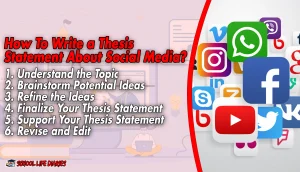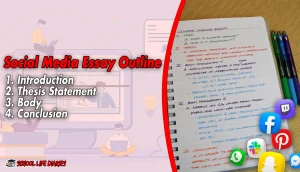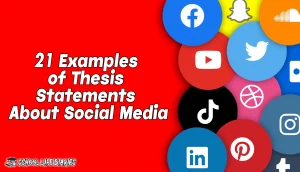With the rise of online platforms and thesis statement social media in our lives, students and teachers alike are increasingly asking questions about whether or not this technology is beneficial to academic performance. While it can be argued that there are both pros and cons to using social media. Many studies now show how integrating different forms of social media into classroom-based teaching can have tremendous positive benefits such as promoting greater collaboration between peers.
Asynchronous learning opportunities for a wider variety of topics, increased engagement among students to participate in activities related to areas of study, improved access to resources outside the textbook, as well as an overall boost in communication with all stakeholders involved within any given educational setting. In this blog post, we will explore these topics and provide a thesis statement about the impacts that social media has today on modern education.
How To Write a Thesis Statement About Social Media?
1. Understand the Topic:
Before attempting to write a thesis statement on social media, it is important to understand the topic. In this case, you need to familiarize yourself with what social media is and what aspects are associated with it. Researching different sources such as news articles, blogs, and academic papers can help provide insight into the topic.
2. Brainstorm Potential Ideas:
After gaining an understanding of the topic, you should brainstorm potential ideas for your thesis statement. Think about what information you found during your research and develop a few statements that capture the essence of it. It is also useful to consider any questions or opinions you have on the subject matter.
3. Refine the Ideas:
Once you have a few potential ideas for your thesis statement, it is time to narrow them down. Evaluate each idea and determine which one best encapsulates the points you want to make about social media. Re-write this statement in its strongest form and consider how it can be further refined.
4. Finalize Your Thesis Statement:
After you have thoroughly examined each idea, you can finalize your thesis statement. Make sure it accurately reflects the points you want to make about social media and that it is written in a clear and concise manner. Once this is done, your thesis statement on social media will be complete.
5. Support Your Thesis Statement:
To make your thesis statement even stronger, it is important to provide evidence and support for your claims. This may involve conducting additional research or gathering statistics that back up what you are saying. Doing this will create a well-rounded argument and help communicate the message of the thesis statement more effectively.
6. Revise and Edit:
The final step in writing your thesis statement is to revise and edit it. Read through the statement several times, paying attention to spelling, grammar, and syntax. You can also ask someone else to read over it as well to ensure that it is clear and accurate. Once everything has been checked, your thesis statement on social media is ready to be presented.
What Is a Social Media Thesis Statement?
A Social Media Thesis Statement is a statement that expresses the key idea of an argument about the influence of social media platforms on modern society. It could be argued that social media has had both positive and negative impacts on people, from creating new opportunities for communication and connection to contributing to issues like cyberbullying, addiction, and data security.
The overall effect of social media on our lives is still unclear and needs further exploration. This thesis statement serves as a starting point for further research into the role of social media in today’s society. Through exploring the effects of social media on individuals, communities, and even global society, we can gain insight into how these platforms are shaping the world we live in.
What Are Social Networks On The Internet?
Social networks on the Internet are online platforms that allow individuals to connect and interact with one another in a virtual space. These networks often involve user profiles, friends lists, and other features that allow users to post content such as photos, text, and videos. Many social networks allow users to comment on others’ posts, join groups, and join conversations.
The use of social networks has become a popular part of everyday life, providing users with a convenient way to stay connected and share information. From personal connections to professional opportunities, these networks offer various benefits that can be utilized by both individuals and businesses.
Do We Know Where Social Networks Originate?
Social networks have become an increasingly popular way of connecting with people all over the world, allowing us to communicate with friends, family, and acquaintances. However, it can be difficult to determine the exact origin of these networks.
The first concept resembling a social network was Six Degrees, which was created by Andrew Weinreich in 1996. This website allowed users to create a profile and connect with other users, as well as find people from around the world. It was successful for a while but eventually failed due to legal issues and a lack of funding.
In 1997, Classmates.com was launched, allowing users to search for former classmates and make connections with them. This was the beginning of social networks becoming an integral part of our lives. Soon after, other popular networks emerged such as Friendster in 2002, LinkedIn in 2003, and MySpace in 2004.
Advantages and Disadvantages of Social Networks On The Internet
Advantages of Social Networks On The Internet
1. Social networks on the internet provide unprecedented levels of connectivity, allowing users to easily interact with each other regardless of geographical location.
2. Social networks can be used to build communities and create conversations around particular topics or ideas.
3. Many social networks have also opened up their platforms to entrepreneurs, allowing small businesses to have the opportunity to market their products and services more effectively.
4. While social networks do offer many benefits, it is important that users remain cautious when using them.
5. Social networks can provide many opportunities for people to make connections, learn about new topics, and gain insight into different perspectives.
Disadvantages of Social Networks On The Internet
1. Excessive personal information sharing can lead to identity theft and fraud.
2. Unregulated content can be misleading or inappropriate for younger viewers.
3. Connecting with strangers online can put users at risk for cyberbullying, scams, and other malicious acts.
4. Increased distractions from social media use can negatively impact school performance and work productivity.
5. Addiction to social networking sites is common among users, leading to a lack of balance between online/offline relationships and activities.
How To Write A Good Social Media Essay?
1. Choose a topic that interests you and your audience
2. Do extensive research to understand the subject better
3. Brainstorm ideas
4. Outline the essay structure
5. Write an attention-grabbing introduction
6. Create well-structured paragraphs with clear arguments supported by evidence
7. Incorporate visuals (e.g., images, videos, gifs) where appropriate to keep readers engaged
8. Make sure your content is relevant and up-to-date according to social media trends
9. End with a strong conclusion summarizing the main points
10. Proofread for grammar and formatting errors before posting.
Social Media Essay Outline
1. Introduction:
The introduction should provide a brief overview of the topic, explaining what social media is and why it is important in our lives today. It should also introduce the main points to be discussed in the essay and provide an overview of relevant research that has been done. The Introduction should conclude with a clearly defined thesis statement.
2. Thesis Statement:
The purpose of this essay is to explore the effects that social media has had on our lives, both positive and negative, and to provide insight into how we can use it in constructive ways.
3. Body:
The body of the essay should begin by looking at the positives of social media, such as its ability to connect people across the globe and how it can be used to share ideas. It should discuss how social media has created new opportunities for businesses and organizations to reach a wider audience and how it can be used to raise awareness about important issues.
4. Conclusion:
In conclusion, although there are both positives and negatives associated with social media, it is clear that used in the right way it can be an incredibly useful and powerful tool for communication. With a few simple steps, such as using proper caution when consuming information and taking breaks from constant use, anyone can enjoy the benefits of this technology without many of its potential drawbacks.
21 Examples of Thesis Statements About Social Media
1. For individuals, social media can be both a blessing and a curse; it provides a platform for increased connectivity, but can also create or exacerbate feelings of loneliness and depression.
2. Social media has been associated with the rise of “echo chambers” that limit the diversity of perspectives people encounter.
3. Social media can also have a serious impact on mental health, as users are exposed to a barrage of both positive and negative information all at once.
4. It is important for individuals to be conscious of their own use of social media, as well as that of others in order to minimize any potential risks associated with it.
5. Setting limits on time spent online, engaging in meaningful conversations, and taking a break from social media can help to reduce any potential negative effects of its use.
6. It is also important to remember that the content posted on social media does not always reflect the reality of people’s lives.
7. It is crucial to remain mindful of what we see on social media and understand its potential impact on our own mental health.
8. We can ensure a safe and healthy online environment for ourselves and those around us.
9. Social media can be an amazing tool to maintain relationships and foster meaningful dialogue, but it is important to keep in mind the potential pitfalls associated with its use.
10. We can make sure that our experiences on social media are both positive and productive.
11. By understanding the potential risks and actively managing our own use of social media, we can ensure that it remains a force for good in our lives.
12. Through increased self-awareness and mindfulness, we can make sure to get the most out of our interactions on social media while avoiding any potential negative effects.
13. It is important to remember that social media should use in moderation and with care so that it can continue to have a positive impact on the lives of its users.
14. By remaining aware of our own use and encouraging others to do the same, we can ensure that social media remains a safe and healthy space for all.
15. It is important to remember the potential benefits and pitfalls of social media and make sure to use it responsibly.
16. We can ensure a safe and enjoyable experience for everyone who uses it
17. Social media can also be a powerful tool for spreading awareness and promoting positive change in the world.
18. Social media can use to advocate for causes that matter and amplify the voices of those who are often unheard.
19. Through thoughtful engagement and meaningful conversations, we can use social media as a platform to create positive change in the world.
20. When used responsibly, social media can be an invaluable tool to help us build better communities and create a more just and equitable world.
21. By understanding the potential impacts of using social media and taking steps to ensure responsible use, we can make sure that it remains a force for good in our lives.
Related Article: Term Paper: Structure And Tips For Writing A Successful Paper
Conclusion:
As we can see from this study, students who use social media in an educational setting perform better than those who don’t. This is likely because social media provides a more engaging and interactive learning environment. While there are many potential benefits to incorporating social media into instruction, such as promoting collaboration and interaction among students.
There are also some challenges that need to take into account, such as managing student screen time and ensuring online safety. If you’re a teacher, consider incorporating social media into your lesson plans. And if you’re a student, be sure to take advantage of the resources that social media has to offer.









